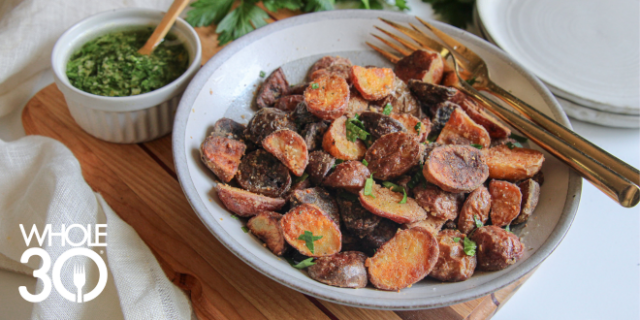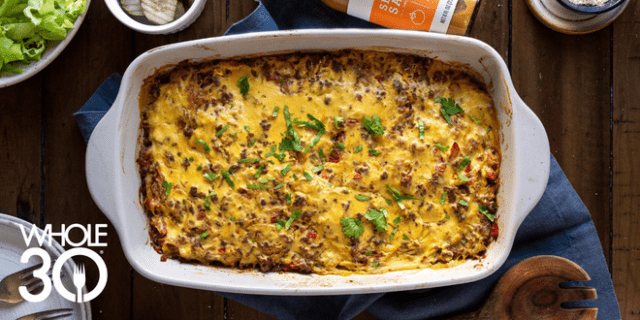
Preview your Whole30 journey, start to finish

The highs! Some lows? We’ll prepare you for all of it.
Big picture, your Whole30 Timeline happens in two phases—30 days of elimination, and 10-15 days (sometimes more) of reintroduction. However, no two weeks on the Whole30 look the same—and while there are plenty of benefits, the program can have its challenges, too.
Since 2009, we’ve guided millions through their Whole30 elimination and reintroduction. At this point, we have a pretty good idea of how your Whole30 is going to look. And we want you to head into your program feeling confident and prepared. Previewing the Timeline before you start will help you plan for every phase, avoid common mistakes, and get excited about the next 30 days.
For each phase of the program, you’ll discover:
- Positives: Benefits, non-scale victories, and positive results often seen in each stage
- Cautions: Common challenges you may encounter along the way
- Strategies: Tips, mindset techniques, and action items to help you succeed at every stage
Your week-by-week Whole30 Timeline
Whole30 alumni say the Timeline helped them better prepare, feel more confident in their program, and successfully navigate challenges. Now, you can preview your Whole30 journey week-by-week.
In this phase, you’ll choose your start date, clean out your pantry, plan some meals, grocery shop, and start cooking in preparation for Day 1. This phase also includes building your support system, creating strategies for challenging situations, planning some “on-the-go” emergency food, and reinforcing your Whole30 mindset.
Your Day 1 experience is greatly influenced by your dietary choices in the days leading up to your Whole30. Cramming in all the sugar, alcohol, bread, and pizza you can before your program starts is a recipe for headaches, crankiness, and lethargy. Many people “soft launch” their Whole30 by conscientiously eating less sugar and processed foods, cutting back on alcohol, and eating more vegetables in the days leading up to their Whole30. This is a fantastic idea—just sayin’.
You can’t be too prepared for the Whole30.
Our planning and preparation guide will help you get ready before your Day 1.
Read nowWelcome to the Whole30! The excitement of your program will see you through the first day or two, feeling energized and confident. But we’ll be honest—this week can be challenging.
The abrupt decrease in added sugar and processed carbs can leave you feeling lethargic, headachy, and brain-foggy until your metabolism adjusts. Cravings for the foods or drinks you’ve eliminated can also make you cranky, fidgety, and easily irritated. (Food dreams are common here, too.) You may also experience bloating, constipation, or loose stools as your gut adjusts and learns to process these new foods more effectively.
Rest assured, it’s not all rough roads! Many people also report improvements in symptoms (including digestive, joint pain and swelling, migraines, and anxiety), better sleep, and fewer cravings once they get through the first few days. Your best strategies are to take a nap or go to bed early; tone down your workouts; drink lots of water; eat Whole30 foods whenever you’re hungry (don’t limit calories or meals); and keep reminding yourself of your Whole30 “why.”
Wondering if your Whole30 symptoms are normal?
Read our guide.You may still be adjusting to this new way of eating, but some things are already feeling better or easier, and you’re surely feeling more confident. By the end of the week, you may notice you’re falling asleep faster, staying asleep longer, and waking with more energy. (Do you still need that 2 PM hit of caffeine?) Your cravings may be down, you’re discovering new ways of navigating stress, you’ve got some new habits, and eating to satiety feels good. And as your taste buds adjust, you’re discovering a newfound appreciation for the sweetness of a strawberry or sweet potato. You may also have noticed a reduction or improvement in symptoms, like acne or eczema, allergies, asthma, migraines, joint pain and swelling, chronic pain, or anxiety.
Digestion can be a mixed bag here. Many have less gas, bloating, constipation, diarrhea, and digestive distress at this point in the program. But if you’re still bloated or irregular on your Original Whole30, try eating more cooked vegetables than raw, eat fewer high-FODMAP veggies and fruits, and eat fruit in smaller servings. If you’re doing the Plant-Based Whole30, are new to eating this many legumes or soy-based protein sources, and are still irregular or bloated, see this troubleshooting guide.
The Original Whole30 low-FODMAP shopping list, covers fruits, veggies, fats, and pantry goods.
See our listOn Days 10 and 11, you are statistically the most likely to quit your Whole30. (That’s why they’re “the hardest days.”) By this point, the newness of the program has worn off, and though you’ve made it through most of the unpleasant physical milestones, you’ve yet to experience significant benefits. This in-between place can leave you feeling impatient, anxious about whether it will be worth it, or tempted to self-sabotage. Those who stick with it have three things in common:
- They have a strong “why,” and focus on the long-term goal.
- They are willing to examine their emotional discomfort and look for other ways to self-soothe. (Journaling, movement, and meditation can all be helpful here.)
- They lean on their in-person and online support system for encouragement, advice, and accountability.
Prepare yourselves for these days, because if you can see them through, things get much easier.
The Whole30 Day by Day to helps you stay motivated, track your non-scale victories, and hold yourself accountable.
Use Whole30 Day by DayBy the third week, most people notice small (or big) non-scale victories (NSVs) in many areas of their lives:
- Energy and sleep
- Mood, anxiety, and depression
- Focus, productivity, and creativity
- Less bloating, swelling, or pain
- Fewer cravings
- Smoother skin
- Lessened or eliminated symptoms
- Improved self-confidence
This may not happen like magic in your third week. A huge number of factors influence which benefits you see and when—and there’s a reason it’s not the Whole20. Trust the process; stay on the lookout for small, gradual improvements to keep you motivated; and celebrate the wins you are seeing. Also, lean on your support system here! Talking about how you feel and asking others to share their positive observations thus far can help keep you motivated.
Don’t let food boredom stand in the way of your Whole30 goals.
Try a new recipe this week!You’ve lost track of the days, because this feels like second nature. The NSVs continue to roll in, and, though you’re excited to reintroduce the foods you’ve been missing, you already know you’ll take a lot of what you’ve learned with you into life after your Whole30.
Start thinking about your reintroduction phase, to ensure you have a solid plan in place. It’s tempting to dive into pizza, beer, and ice cream on Day 31. The Whole30 can teach you so much about how foods work for you, but not until you eliminate and reintroduce them carefully, and then compare your experience. Your Whole30 isn’t done until you’ve finished reintroduction. And reintroduction brings you one step closer to your own Food Freedom plan.
Finish this week by revisiting your favorite Whole30 meals. Start planning your reintroduction schedule and shopping for the first few foods or beverages you’ll be reintroducing. For extra credit, start reading or listening to Food Freedom Forever to prepare for the next phase of your Whole30 journey.
Use our Reintroduction guide to help you create your plan for Whole30 Day 31
Time to celebrate your Whole30 accomplishment! You made a promise to yourself, and you kept that promise. You’ve developed new healthy habits; discovered other ways to self-soothe, navigate stress, and relieve anxiety; expanded your kitchen and cooking skills; and improved your self-confidence and self-efficacy.
You’ll spend these 10-15 days (or longer) in reintroduction, bringing back one food group at a time, then returning to the Whole30 elimination for 2-3 days in between. Pay attention to how the reintroduction of these foods impacts your energy, sleep, digestion, mood, cravings, aches, pains, and health conditions. This experience will inform your Food Freedom plan, helping you make the right decisions for you about the foods that are “worth it” in life after the Whole30.
Many alumni stay closely connected to the Whole30 community even after their program is over. Continuing to share your Whole30 learnings can help motivate and inspire others, keep you firmly entrenched in your healthy habits, and help you continue to refine your Food Freedom plan.
Food Freedom Forever will get excited about life after the Whole30.
Read or listen- Tidying a small area
- Paying a few bills
- Writing and addressing a thank-you note
- Chopping some vegetables
- Going outside for a few minutes
- Reading a few pages of your book
- Journaling your feelings
- Making a pot of herbal tea
- Doing a few simple stretches
- Time: Your gut flora and digestive enzymes may need time to adapt to the veggies and protein you’re consuming more of during your Whole30.
- Fiber: You are likely eating far more fiber on your Whole30 (from vegetables and fruit, or on a Plant-Based Whole30, from legumes). A dramatic increase in fiber can lead to gas and bloating.
- FODMAPs: An increase in fermentable carbohydrates from veggies and fruits (like onions, garlic, cauliflower, apples, or bananas) can promote the same symptoms.
- Alternative flours: Even if you’re not baking with them, using large amounts of almond or cassava flour in frittatas, meatballs, or other meals can promote digestive distress.
- Nuts or nut butters: This is another common culprit in digestive issues, especially if you’re consuming large quantities
- Fats (like coconut oil, ghee, or coconut milk): Yes, coconut milk is delicious in a smoothie and your coffee may taste delicious with ghee, but eating too much fat for your context can promote digestive upset and diarrhea.
- Prepare your eggs differently (hard-boil, poach, scramble, or make a frittata)
- Make some new recipes
- Add a new dressing or sauce
- Shop for new vegetables, or prepare them a new way (roasting or air frying are our favorite)
- Build in variety with Whole30 compatible meals from Made By Whole30 meals (Original Whole30) or Daily Harvest (Plant-Based Whole30)
- Swap Whole30 recipes with a friend or someone on Instagram





























